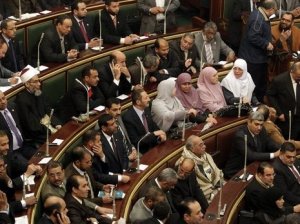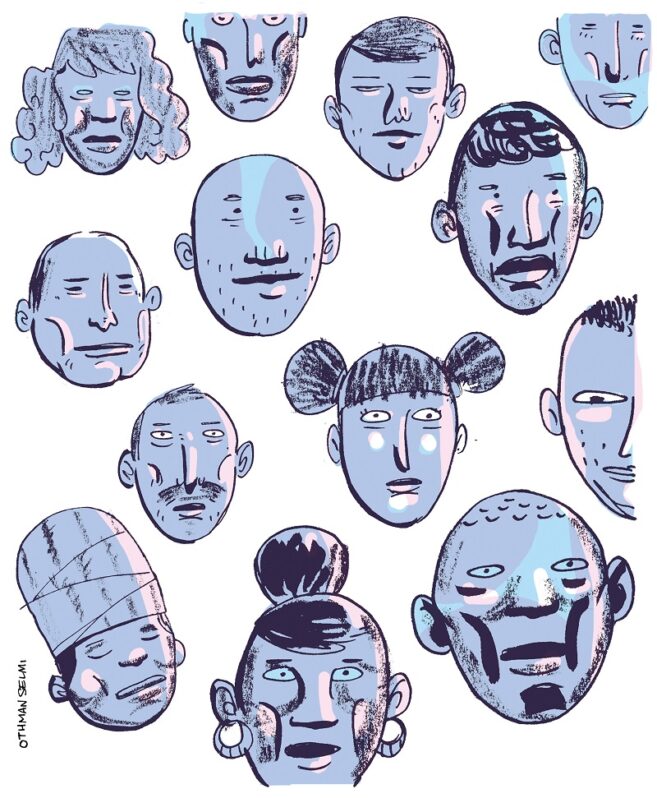Women, Minorities and Marginalized Groups in Egypt (2011-2013) (II) The First Post-Revolutionary Parliament

For the author’s introductory note on this series and its phases of study, refer to the study of the first phase.
The main feature of this second phase, extending from January to June 2012, was the election of the first post-revolutionary People’s Assembly. This so-called “revolutionary parliament” began its work with the Supreme Council of the Armed Forces (SCAF) heading the executive branch of the government.
Another prominent feature of this phase was the ascension of political Islamist movements to power by winning the majority of seats in both the People’s Assembly and the Shura Council. This phase thus witnessed the early stages of the transfer of power and the building of state institutions, as well as the first step towards laying down a new Egyptian constitution.
This part of our series addresses the situation of women, minorities and marginalized groups in parliamentary discussions and legislation, as well as in the formation of the Constituent Assembly (CA).
Women and Copts at the Revolutionary Parliament: Weak Representation Despite High Participation
In order to discuss the parliament’s approach to the issues of women, minorities and marginalized groups, one must first examine the composition of this parliament and how these groups were represented in it.
The parliamentary election law did not stipulate a quota for women or other groups. Moreover, the law did not require placing the names of female candidates in the top third of electoral lists, merely stating that the latter should include at least one female candidate. Consequently, most electoral lists, even secular ones, placed the names of their female candidates at the bottom of the list. In fact, secular electoral lists did not nominate many women as candidates, with the highest percentage of female candidates reaching a mere 16% on the lists of the Revolution Continues Alliance.[1]
In 2012, the percentage of female representation amounted to a mere 2% in the People’s Assembly and 2.7% in the Shura Council, despite women having widely participated in the elections, both as candidates and as voters.[2] Indeed, 984 women[3] ran as candidates in the People’s Assembly elections, as part of electoral lists or competing for individual seats, while 396 ran in the Shura Council elections.[4] Moreover, the number of women eligible to vote reached 23.5 million.[5] Women were present at polling stations and actively participated in the voting process.
This reflects the fact that the absence of quota requirements for women is not the only problem. The approach of political parties and coalitions to the very notion of female candidates, and the extent of their trust in women’s capabilities are equally problematic.
Coptic participation in parliamentary elections was positive as well. The late Pope Shenouda III had called on Copts to participate and choose their candidates on the basis of patriotism, not religious affiliation.[6] However, the urging of their church was not the only reason for the participation of Copts in parliamentary elections and earlier in the referendum. In fact, the main reason may well be that, since the January 25 Revolution, Copts have joined street protests and participated in political life, forming movements and taking part in the activity of political parties. Additionally, their participation may have stemmed from the fear that their rights and freedoms would suffer, should political Islam seize power.
Saint Mark’s Coptic Orthodox Cathedral in Alexandria, the seat of the Coptic Papacy, estimated the rate of participation of Copts in parliamentary elections at about 70%, which it considered unprecedented.[7] Yet, no more than eleven Copts obtained seats in the People’s Assembly (six of them elected and five appointed by SCAF), which constituted a mere 2% of the overall number of seats.
Parliamentary Proposals: The Absence of the Principle of Citizenship
The parliament did not produce much legislation, but the discussions that took place within its walls and the statements made by its members are considered valuable material for analysis.
In terms of women’s issues, a single law was passed in May 2012, namely, the law regulating health insurance for working women. [8] On the other hand, there were numerous proposals to amend laws granting women certain rights under the pretext that such laws were at odds with the principles of Islamic law, and were the making of the former First Lady Suzanne Mubarak.
The first such proposal was made in March 2012. A representative of the People’s Assembly Legislative Committee presented a draft law to revoke Article 20 of a law passed in 2000. The latter, known as the “no-fault divorce law” (khul), regulates certain personal status law issues and litigation procedures.[9] The proposal was referred to the Al-Azhar University to determine its consistency with Sharia. The no-fault divorce law was recognized by Al-Azhar as consistent with Sharia,[10] and the proposed amendment was rejected.
This was followed by a string of draft laws demanding the amendment of laws concerning women. Thus, in April 2012, one MP from the Salafist al-Nour Party presented a draft law to change the age of custody. Certain articles of Egyptian personal status law regarding guardianship had been amended in 2005, and the age until which the mother could hold child custody had been raised to 15 years. The Salafist MP demanded that the age of custody be lowered to 7 for boys and 9 for girls.[11] In a related but unprecedented occurrence, a female MP from the Muslim Brotherhood’s Freedom and Justice Party (FJP) presented a draft law to amend Article 242 Bis of the Penal Code, which criminalizes female circumcision (female genital mutilation). The FJP MP demanded that the law merely ban female circumcision outside of hospitals, and require a specialized medical consultation indicating the need for circumcision.[12] In a statement, the same MP claimed to have put forward a proposal to revoke the sexual harassment law. She justified this by claiming that women cause sexual harassment by displaying their naked flesh, and that the men who engage in it are therefore not at fault.[13]
Another al-Nour Party MP later presented a draft law to revoke the law criminalizing female circumcision. However, the party withdrew their proposal from the Proposals and Complaints Committee on the grounds that the MP had failed to consult with the head of al-Nour’s parliamentary group before presenting it to the People’s Assembly.[14] The al-Nour Party also put forward a draft law to lower the marriage age from 18 to 16 years of age. It justified this by claiming that citizens in remote areas wished to marry off their daughters at a younger age, and that legislators should respect their wishes.[15]
While showing a great deal of legislative interest in women’s issues, Islamist Members of Parliament never presented draft laws to resolve the problem of building houses of worship for Copts, or the problems faced by the Nubians, the Sinai Bedouins and other marginalized groups. This only increased the fears of some that the rise to power of political Islam would do away with women’s rights and turn the clock back for Egyptian women. It further exposed the lack of clear strategic vision for addressing issues relating to marginalized groups, as well as ones that directly affect citizens.
The Constituent Assembly (CA): The Era of Exclusion
In March 2012, the Constituent Assembly (CA) was formed to draft the Constitution. Its members were elected from among those of Egypt’s two houses of parliament, the People’s Assembly and the Shura Council.[16] The FJP and the al-Nour Party held the majority of CA seats.[17]
Some feminist movements and organizations had demanded that 50% of the CA be composed of women. In an official speech to the People’s Assembly and the Shura Council, the National Council for Women (NCW) set the minimum at 30%.[18] Yet in the end, women only made up 6% of the Constituent Assembly.[19] Copts, as well as marginalized groups such as people with disabilities, were not represented at all in the CA. This was also the case for the Nubians, who protested in April 2012 against the CA’s formation in front of the Aswan governorate building.[20]
The Constituent Assembly was thus the target of a large number of lawsuits calling for its invalidation and dissolution. Indeed, a ruling invalidating the CA was issued by the Administrative Judicial Court on April 10, 2012.[21] The former Speaker of the People’s Assembly issued a decision on April 18, 2012 charging the People’s Assembly’s own Constitutional Affairs Committee with the task of preparing a draft law, that would clearly define the standards for electing another formal body to draft the constitution.[22] On June 12, 2012, two days before the ruling to dissolve the People’s Assembly was issued, the members of the second Constituent Assembly were elected.[23]
Women made up a mere 7% of this second CA (7 women out of 100 members).[24] Copts and other Christian denominations were represented by their respective churches. As for people with disabilities, Nubians and Bedouins, they were not represented at all.[25] Such exclusion reflected on the work and statements of the CA, and it too was the target of a number of lawsuits calling for its invalidation. The work of this second Constituent Assembly, as well as the text of the 2012 Constitution, which took place after ousted President Mohamed Morsi came to power, will be discussed in Part III of this series.
This article is an edited translation from Arabic.
__________
[1] See: “2012: The Year of Women’s Great Emergence”, report published by the Egyptian Center for Women’s Rights (ECWR), January 2013.
[2] See note 1 above, idem.
[3] See: Nehad Abul Komsan’s, “In the 2012 Parliament: What Did Women Lose and What did Egypt Lose?”, report published by the Egyptian Center for Women’s Rights (ECWR), December 2012.
[4] See note 1 above, idem.
[5] See note 3 above, idem.
[6] Published in the al-Shorouk newspaper on November 17, 2011.
[7] Published on the al-Masry al-Youm website on November 30, 2011.
[8] See note 1 above, idem.
[9] See note 1 above, idem.
[10] See note 1 above, idem.
[11] See: Dina Diab’s, “Lowering the Age of Custody: A Man’s Law to Destroy Women”, published on the al-Wafd website on May 4, 2012.
[12] See note 1 above, idem.
[13] See: MP Azza el-Garf’s interview with the al-Ahram newspaper youth section, published on April 4, 2012.
[14] Published on the al-Masry al-Youm website on May 18, 2012.
[15] See: Fadia Abboud’s, “Lowering the Marriage Age: Trading in Daughters and no Protection”, published on the al-Wafd website on March 27, 2012.
[16] Constitutional Declaration issued on March 30, 2011.
[17] See: “Full List of Members of the Constituent Assembly to Draft Egypt’s Post-Revolutionary Constitution”, published on the al-Shorouk website on March 25, 2012.
[18] al-Masry al-Youm website, March 8, 2012.
[19] al-Shorouk website, March 28, 2012.
[20] Published on the al-Youm al-Sabea website on April 3, 2012.
[21] See details of the ruling published on the Sout al-Omma website on May 28, 2012.
[22] See: Waheed Abdul Majeed’s, “The Full Story of the Battle of the Constituent Assembly”, published on the al-Shorouk website on June 21, 2012.
[23] See note 22 above, idem.
[24] el-Watan website, June 12, 2012.
[25] el-Watan website, July 27, 2012.
Mapped through:
Articles, Egypt, Gender, Sexuality and Women Rights, Inequalities, Discrimination and Marginalisation
Related Articles



